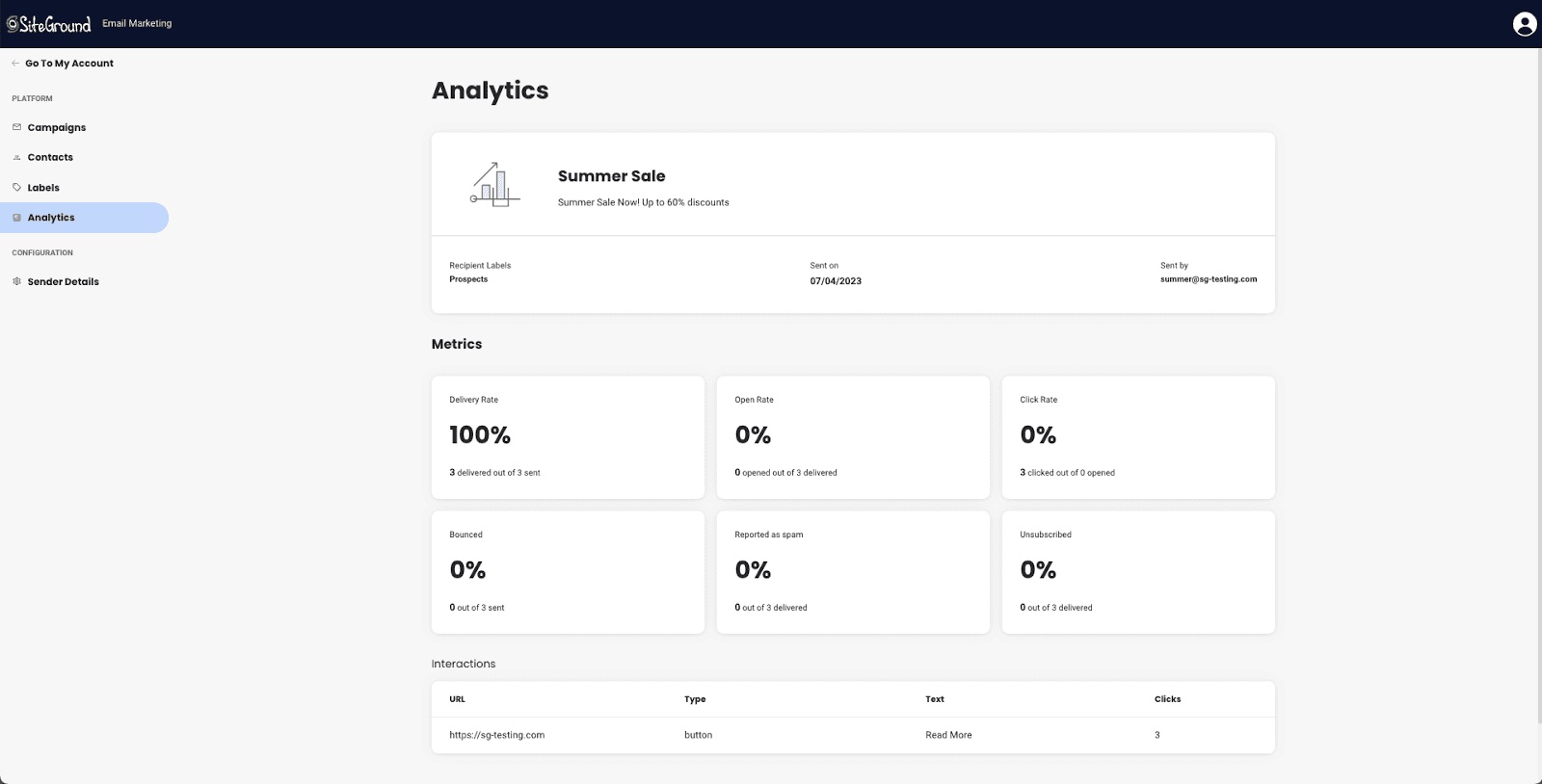What do different metrics on the Analytics page mean?
Table of Contents
Email marketing is a powerful tool for businesses to connect with their audience, generate leads, and drive conversions. However, to gauge the effectiveness of email campaigns, it is crucial to track and analyze various email marketing metrics. These metrics provide valuable insights into the performance of your email campaigns and help you make data-driven decisions to optimize your marketing efforts.
In this article, we will explore the significance of SiteGround Email Marketing Analytics page metrics.
Importance of understanding the email marketing metrics
Email marketing metrics play a vital role in evaluating the success of your campaigns and understanding customer engagement. By tracking these metrics, you gain valuable insights into the effectiveness of your email marketing strategies and can make informed decisions to improve your campaigns.

Analytics page metrics meanings
Open Rate
The open rate measures the percentage of recipients who open your emails. It indicates the effectiveness of your subject lines and overall email content in grabbing attention and enticing recipients to open the email.
Delivery Rate
The delivery rate is an important email marketing metric that measures the percentage of emails successfully delivered to recipients’ inboxes. It tells us how effectively our emails are making their way through the digital labyrinth and reaching the intended destination.
Click Rate
The click rate measures the percentage of recipients who click on links within your emails after they open the email. It helps evaluate the relevance and effectiveness of your email content and call-to-action (CTA).
Bounced
The bounce rate measures the percentage of emails that are not delivered to recipients’ inboxes due to Hard or Soft bounces. High bounce rates can indicate issues with your email list quality or email deliverability.
Contacts from whom you receive hard bounces are automatically added to the Suppressed tab of the Contacts page. Such contacts will not be emailed again unless you manually change their status. This is due to the fact that hard bounces indicate a permanent reason for the recipient email server to reject the messages. That helps maintain the integrity of your emailing list. It prevents future emails from being sent to hard-bouncing addresses, thus improving deliverability and sender reputation.
Contacts from whom you receive soft bounces are not removed from your mailing list, since the reason may be temporary. Thus, future attempts at mailing them are likely to result in success.
Reported as spam
This metric measures the percentage of emails, that the recipients reported as spam. Contacts reporting your email as spam are listed in the Unsubscribed section on the Contacts page. This action ensures compliance with anti-spam legislation and respects the recipients’ preferences. It helps to evaluate the relevance of the email content, the target audience, and the quality of the email in general.
Unsubscribed
The unsubscribe rate measures the percentage of recipients who choose to unsubscribe from your email list. Monitoring this metric helps you understand how engaging and relevant your content is to your audience. Unsubscribed contacts are automatically placed under the Unsubscribed tab on the Contacts page. That ensures that they do not receive future communications that they have opted out of, thus preserving your brand’s reputation and respecting user choice.
Interaction metrics
The interaction metrics can be found under the Metrics section on the same page (the Analytics page). These metrics will help you analyze your call-to-action efforts and the interactions made by the recipients with your email campaign. The interaction metrics are the following:
URL
The URL refers to the destination page that you want to direct your email recipients to. It is the specific web address or link that leads to a particular webpage or resource. The URL serves as the target destination for users when they click on a link or call-to-action in the email.
Type
The type refers to the clickable element that contains the URL. This can either be a link, button, image or the header in your email.
Text
The text is the visible content on the button or link that users see. It serves as an invitation for users to take action and click. It is also known as anchor text, as it anchors the link to the specific text displayed.
Clicks
Clicks represent the total number of times that users have clicked on a particular call-to-action (CTA). This metric measures the engagement and interest generated by the CTA, indicating how many recipients have interacted with it by clicking.